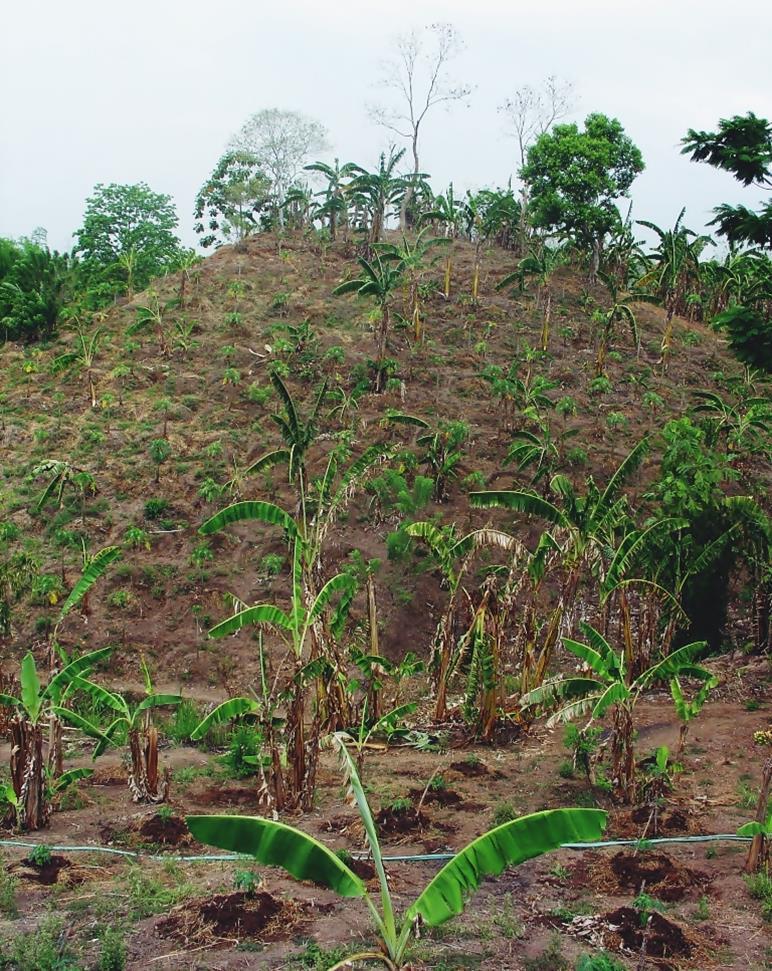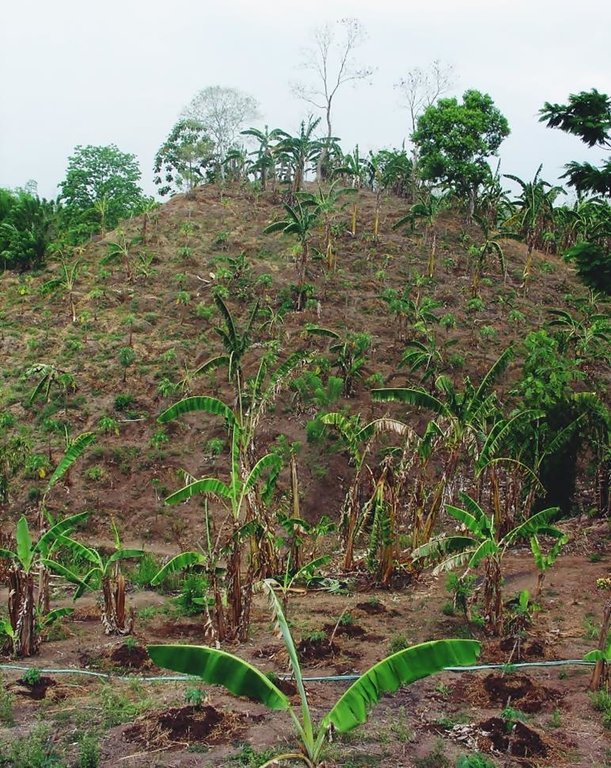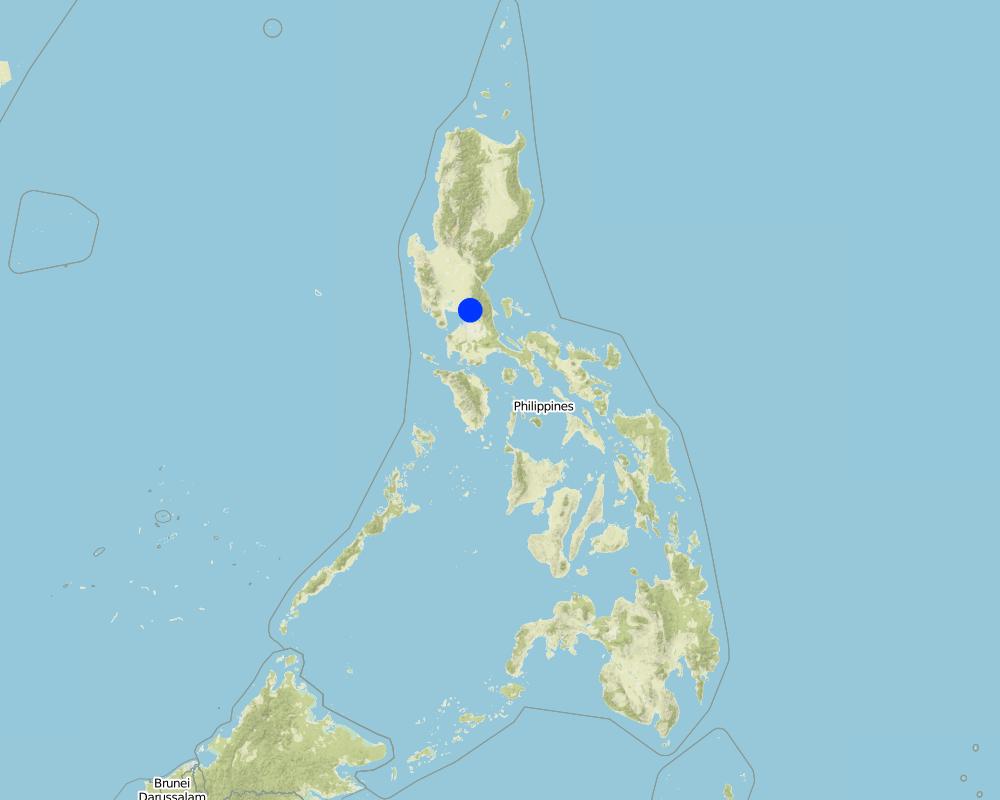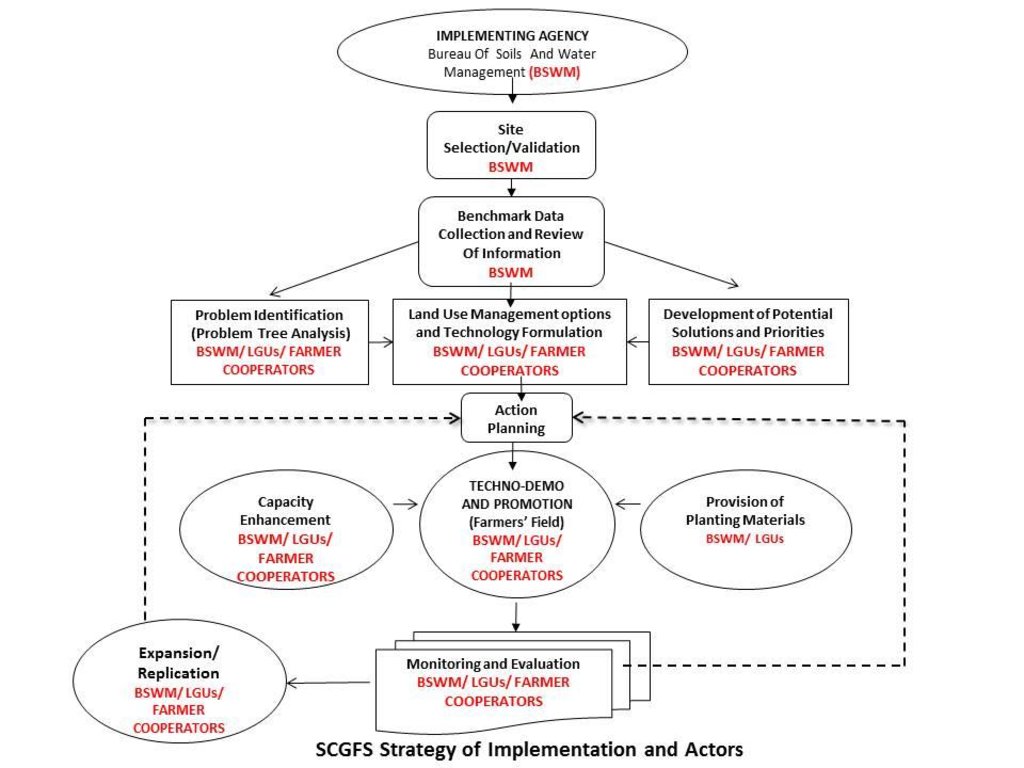Soil Conservation Guided Farm System [Philippines]
- Création :
- Mise à jour :
- Compilateur : Philippine Overview of Conservation Approaches and Technologies
- Rédacteur : –
- Examinateur : Deborah Niggli
SCGFS, Guided Farm, Guided Farm Project
approaches_1973 - Philippines
Voir les sections
Développer tout Réduire tout1. Informations générales
1.2 Coordonnées des personnes-ressources et des institutions impliquées dans l'évaluation et la documentation de l'Approche
Personne(s) ressource(s) clé(s)
Spécialiste GDT:
Spécialiste GDT:
Spécialiste GDT:
Spécialiste GDT:
Dacumos Evangeline
Bureau of Soils and Water Management
Philippines
Spécialiste GDT:
Creencia Rogelio
Bureau of Soils and Water Management
Philippines
Spécialiste GDT:
Raquid Jemar
Bureau of Soils and Water Management
Philippines
Spécialiste GDT:
Guillermo Josephroel
Bureau of Soils and Water Management
Philippines
Nom du projet qui a facilité la documentation/ l'évaluation de l'Approche (si pertinent)
Decision Support for Mainstreaming and Scaling out Sustainable Land Management (GEF-FAO / DS-SLM)Nom du ou des institutions qui ont facilité la documentation/ l'évaluation de l'Approche (si pertinent)
Department of Agriculture-Region VIII (DA-8) - Philippines1.3 Conditions relatives à l'utilisation par WOCAT des données documentées
Quand les données ont-elles été compilées (sur le terrain)?
29/06/2016
Le compilateur et la(les) personne(s) ressource(s) acceptent les conditions relatives à l'utilisation par WOCAT des données documentées:
Oui
1.4 Références au(x) questionnaire(s) sur les Technologies de GDT
2. Description de l'Approche de GDT
2.1 Courte description de l'Approche
Soil Conservation Guided Farming System (SCGFS) is a land use management approach that integrates technologies: terracing, agro-pastoral technology, multi-storey cropping, and contouring within the socio-economic and bio-physical limitations of upland areas for optimum development of soil and water resource in a sustainable manner.
2.2 Description détaillée de l'Approche
Description détaillée de l'Approche:
Generally, SCGFS aims to promote sustainable land use management that provides agricultural livelihood while protecting and maintaining environmental sustainability in the upland areas of the country. Its specific objectives: (1) Establish community-based and farmer-managed techno demo farms cum learning centers on soil and water conservation in marginal uplands and watersheds of Small Scale Irrigation Projects (SSIPs); (2) Promote and disseminate effective soil and water conservation approaches and technologies for broader adoption; and (3) Develop a strong linkage and partnership among local stakeholders and cooperators to protect our upland resources and watersheds.
Participatory Approach amongst stakeholders as spearheaded by the Bureau of Soils and Water Management (BSWM) through the Soil Conservation and Management Division (SCMD)
Stages of implementation: (1) Coordination with the Local Government Units (LGU) and consultation with farmers; (2) Memorandum of Agreement (MOA) preparation; (3) Reconnaissance survey (a. Site selection/ identification b. Dialogue with farmer cooperators); (4) Field Survey/Ground Truthing (Topographic survey, Land Resources survey); (5) Maps Preparation( Topographic Map, Soil Map, Land Use Map, Slope Map and Erosion Map); (6) Preparation of preliminary Farm Development Plan; (7) Presentation of Farm Development Plan to the LGUs and Farmer Cooperators (Discussion, Revision/modification); (8). Preparation of Project Study Report (Final Farm Development Plan); (9) Institutional Development/ Capacity Building; (10) Implementation Stage / Farm Development; (11)Conduct of season long farmer field school; and (12) Monitoring and Evaluation including Operation and Maintenance.
Role of stakeholders: A. Bureau of Soils and Water Management (BSWM):
1. Provide the over-all direction in the preparation of plans and programs for the implementation of soil and water conservation through the SCGFS;
2. Provide technical support and assistance in the promotion and implementation of soil and water conservation and in the conduct of capacity building activities (i.e. in terms of training modules and resource persons);
B. Partner agencies/institutions (e.g. LGUs and other concerned agencies):
1. Prepare and endorse request to the BSWM for the establishment of SCGFS as demo farm of soil and water conservation technologies;
2. Provide technical support and assistance to the co-operators in the conduct of field survey and investigation, preparation of soil conservation farm plan, establishment of the SCGFS, and undertaking the necessary training activities;
3. In coordination with BSWM, assist the co-operators in availing necessary farm inputs and facilities for the establishment of the SCGFS; and
4. Undertake monitoring and assessment of operation and maintenance of established SCGFS to immediately address on-farm problems.
C. The Farmer Cooperators (i.e. interest groups/individuals):
1. Signify their interest to establish soil and water conservation demo farm through formal request to the BSWM;
2. Be willing to provide their own resources in the establishment of the demo farm;
3. Provide support and assistance to BSWM in the conduct of field survey and investigation;
4. Act as extension agents in the local community to disseminate soil and water conservation technologies with the demo farm as the community learning center.
2.3 Photos de l'approche
2.5 Pays/ région/ lieux où l'Approche a été appliquée
Pays:
Philippines
Région/ Etat/ Province:
Bulacan
Map
×2.6 Dates de début et de fin de l'Approche
Indiquez l'année de démarrage:
2002
2.7 Type d'Approche
- fondé sur un projet/ programme
2.8 Principaux objectifs de l'Approche
SCGFS aims to promote sustainable land use management that provides agricultural livelihood while protecting and maintaining environmental sustainability in the upland areas of the country. Its specific objectives: (1) Establish community-based and farmer - managed techno demo farms cum learning centers on soil and water conservation in marginal uplands and watersheds of SSIPs; (2) Promote and disseminate effective soil and water conservation approaches and technologies for broader adoption; and (3) Develop a strong linkage and partnership among local stakeholders and cooperators to protect our upland resources and watersheds.
2.9 Conditions favorisant ou entravant la mise en œuvre de la(des) Technologie(s) appliquée(s) sous l'Approche
disponibilité/ accès aux ressources et services financiers
- favorise
Support from BSWM, Department of Agrarian Reform (DAR) & LGUs; Income Generating Technologies
cadre institutionnel
- favorise
Organized farmers association
connaissances sur la GDT, accès aux supports techniques
- favorise
Capacity building, Farmers Field School
charge de travail, disponibilité de la main-d'œuvre
- favorise
Provide additional labor
3. Participation et rôles des parties prenantes impliquées dans l'Approche
3.1 Parties prenantes impliquées dans l'Approche et rôles
- exploitants locaux des terres / communautés locales
- Spécialistes de la GDT/ conseillers agricoles
- gouvernement local
Local Government Unit
Si plusieurs parties prenantes sont impliquées, indiquez l'organisme chef de file ou l'institution responsable:
Land user groups
3.2 Participation des exploitants locaux des terres/ communautés locales aux différentes phases de l'Approche
| Participation des exploitants locaux des terres/ communautés locales | Spécifiez qui était impliqué et décrivez les activités | |
|---|---|---|
| initiation/ motivation | passive | BSWM initiates the establishment of the project. Field surveys i.e site validation, topographic surveys etc. are conducted by BSWM technical staffs. |
| planification | interactive | Planning involves both BSWM and LGUs, technology/ies to be established is/are dependent on the biophysical limitation of the area and the needs of farmer cooperators. |
| mise en œuvre | interactive | Implementation of the project requires participatory involvement amongst stakeholders. |
| suivi/ évaluation | interactive | BSWM, LGUs and farmer cooperators are responsible in the monitoring and evaluation of the established technologies, these will ensure continued adaptation of the technology. |
3.3 Diagramme/ organigramme (si disponible)
3.4 Prises de décision pour la sélection de la Technologie/ des Technologies
Indiquez qui a décidé de la sélection de la Technologie/ des Technologies à mettre en œuvre:
- principalement les spécialistes de la GDT, après consultation des exploitants des terres
4. Soutien technique, renforcement des capacités et gestion des connaissances
4.1 Renforcement des capacités/ formation
Une formation a-t-elle été dispensée aux exploitants des terres/ autres parties prenantes?
Oui
Spécifiez qui a été formé:
- exploitants des terres
- personnels/ conseillers de terrain
Formats de la formation:
- entre agriculteurs (d'exploitants à exploitants)
- zones de démonstration
Formats de la formation:
- organization, capacity building
Thèmes abordés:
Soil and Water Conservation Measures, Land Degradation, Soil Erosion Issues.
4.2 Service de conseils
Les exploitants des terres ont-ils accès à un service de conseils?
Oui
Décrivez/ commentez:
BSWM is the implementing agency. Advises are coming from the experts/ specialists of BSWM.
4.3 Renforcement des institutions (développement organisationnel)
Des institutions ont elles été mises en place ou renforcées par le biais de l'Approche?
- oui, un peu
Spécifiez à quel(s) niveau(x), ces institutions ont été renforcées ou mises en place:
- local
Décrivez l'institution, ses rôles et responsabilités, ses membres, etc.
Needy family heads
4.4 Suivi et évaluation
Le suivi et l'évaluation font ils partie de l'Approche? :
Oui
Si oui, ce document est-il destiné à être utilisé pour le suivi et l'évaluation?
Non
4.5 Recherche
La recherche a-t-elle fait partie intégrante de l’Approche?
Non
5. Financement et soutien matériel externe
5.1 Budget annuel de la composante GDT de l'Approche
Si le budget annuel précis n'est pas connu, indiquez une fourchette:
- 2 000-10 000
Commentez (par ex. principales sources de financement/ principaux bailleurs de fonds):
Government (technical assistance i.e field surveys, provision of planting materials) 20%, local government (technical assistance, planting materials) 60%, local land users (labor, care and maintenance) 20%
5.2 Soutiens financiers/ matériels fournis aux exploitants des terres
Les exploitants des terres ont-ils reçu un soutien financier/ matériel pour la mise en œuvre de la Technologie/ des Technologies?
Non
5.3 Subventions pour des intrants spécifiques (incluant la main d'œuvre)
- équipement
| Spécifiez les intrants subventionnés | Dans quelle mesure | Spécifiez les subventions |
|---|---|---|
| machines | entièrement financé | |
- intrants agricoles
| Spécifiez les intrants subventionnés | Dans quelle mesure | Spécifiez les subventions |
|---|---|---|
| semences | entièrement financé | |
- infrastructures
| Spécifiez les intrants subventionnés | Dans quelle mesure | Spécifiez les subventions |
|---|---|---|
| Greenhouse, Access Roads | entièrement financé | |
Si la main d'œuvre fournie par les exploitants des terres était un intrant substantiel, elle était:
- volontaire
5.4 Crédits
Des crédits ont-ils été alloués à travers l'Approche pour les activités de GDT?
Non
5.5 Autres incitations ou instruments
D'autres incitations ou instruments ont-ils été utilisés pour promouvoir la mise en œuvre des Technologies de GDT?
Non
6. Analyses d'impact et conclusions
6.1 Impacts de l'Approche
Est-ce que l'Approche a aidé les exploitants des terres à mettre en œuvre et entretenir les Technologies de GDT?
- Non
- Oui, un peu
- Oui, modérément
- Oui, beaucoup
SCGFS involves the development of farming systems that adopts appropriate land uses, proper combination of crop and animal commodities, and the right mix of soil and water conservation practices. Thus, these measures ensures development in land use, livestock production and conservation measures.
Est-ce que l'Approche a autonomisé les groupes socialement et économiquement défavorisés?
- Non
- Oui, un peu
- Oui, modérément
- Oui, beaucoup
The approach aids in income generation for needy family heads.
Est-ce que l'Approche a conduit à améliorer la sécurité alimentaire et/ou la nutrition?
- Non
- Oui, un peu
- Oui, modérément
- Oui, beaucoup
Crop diversification helps needy farmers increase their income. Farmers who have undergone SLM training have more exposure to sustainable land use management that would help them improve and widen their knowledge in their farming activities.
Did other land users / projects adopt the Approach?
- Non
- Oui, un peu
- Oui, modérément
- Oui, beaucoup
Adjacent farms/ barangays and other sloping areas of the Philippines
Did the Approach lead to improved livelihoods / human well-being?
- Non
- Oui, un peu
- Oui, modérément
- Oui, beaucoup
Adaptors continue to rise, and with that more farmers generated more income, thus they were able to send their children to school and purchase properties.
6.2 Principale motivation des exploitants des terres pour mettre en œuvre la GDT
- augmenter la production
One of the main purpose of the approach is to help farmers increase their production.
- conscience environnementale
Farmers will generate income while conserving the land.
- well-being and livelihoods improvement
6.3 Durabilité des activités de l'Approche
Les exploitants des terres peuvent-ils poursuivre ce qui a été mis en œuvre par le biais de l'Approche (sans soutien extérieur)?
- oui
Si oui, décrivez de quelle manière:
Technologies are already established and proven to be socially acceptable and economically viable. Farmer cooperators are equipped with technical knowledge they obtained from seminars and training provided by the approach. With these, it ensures sustainability of the project with farmer's own initiative.
6.4 Points forts/ avantages de l'Approche
| Points forts/ avantages/ possibilités du point de vue de l'exploitant des terres |
|---|
| New opportunities for other projects from government |
| Learning center for other barangays |
| Organization of farmers into cooperatives/associations |
| Points forts/ avantages/ possibilités du point de vue du compilateur ou d'une autre personne ressource clé |
|---|
| Participatory/Interactive method |
| Serves as a learning center for other barangay or farmers |
| Easy to adapt |
| Multi-sectoral involvement |
| Transfer of technologies to farmer beneficiaries |
6.5 Faiblesses/ inconvénients de l'Approche et moyens de les surmonter
| Faiblesses/ inconvénients/ risques du point de vue de l’exploitant des terres | Comment peuvent-ils être surmontés? |
|---|---|
| No major concern in the weaknesses / disadvantages of the approach. |
| Faiblesses/ inconvénients/ risques du point de vue du compilateur ou d'une autre personne ressource clé | Comment peuvent-ils être surmontés? |
|---|---|
| Low budget for the establishment of techno-demo | Establish linkages with Local and International funding institutions; development of research proposals for possible funding. |
| Lack of research component particularly in economic and ecological analysis/assessment | Conduct on-site research studies; engage State/Universities and Colleges (SUCs) in research activity. |
7. Références et liens
7.1 Méthodes/ sources d'information
- visites de terrain, enquêtes sur le terrain
- interviews/entretiens avec les exploitants des terres
7.2 Références des publications disponibles
Titre, auteur, année, ISBN:
San Jose del Monte Soil Conservation Guided Farm Project: A success Story, Madrid Agribusiness Digest, 2012,pp 36
Disponible à partir d'où? Coût?
1.28 USD
Liens et modules
Développer tout Réduire toutLiens
Aucun lien
Modules
Aucun module trouvé






